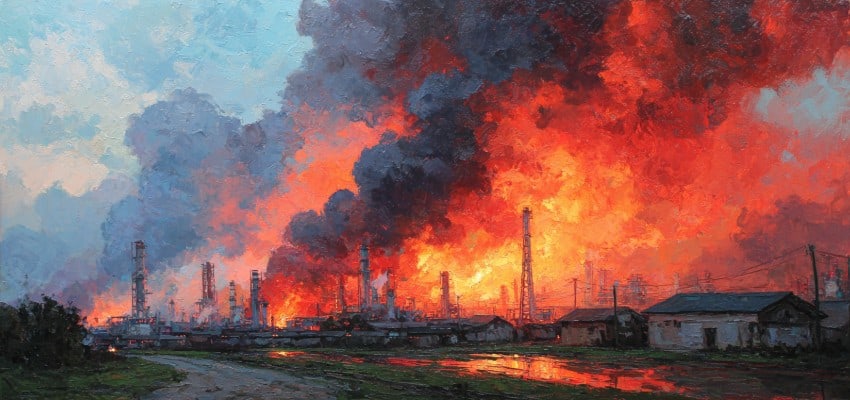Editor’s Note: Ukraine’s latest series of coordinated drone strikes against Russian refineries and military production sites signals a deliberate escalation in the use of precision, long-range technologies to cripple critical infrastructure. For cybersecurity, information governance, and eDiscovery professionals, this development underscores a strategic convergence of digital intelligence, military logistics, and operational accountability. The targeted attacks on communication equipment manufacturers and gas pipelines reflect how modern warfare increasingly depends on and disrupts complex data and supply chains. At the same time, mounting evidence of Russian violations of international humanitarian law—ranging from perfidious troop movements to indiscriminate strikes on civilian areas—raises urgent questions about the enforcement of legal norms in hybrid conflict. As the operational and legal fronts converge, tracking how accountability mechanisms evolve will be essential for professionals navigating this volatile intersection of law, technology, and warfare.
For those seeking to grasp the full scope of this evolving landscape, the complete updates from the Institute for the Study of War serve as an invaluable resource.
Content Assessment: Legal Fault Lines in Modern War: Ukraine’s Strategy vs. Russia’s Violations
Information - 94%
Insight - 91%
Relevance - 91%
Objectivity - 94%
Authority - 95%
93%
Excellent
A short percentage-based assessment of the qualitative benefit expressed as a percentage of positive reception of the recent article from ComplexDiscovery OÜ titled, "Legal Fault Lines in Modern War: Ukraine’s Strategy vs. Russia’s Violations."
Background Note: ComplexDiscovery’s staff offers distinctive perspectives on the Russo-Ukrainian war and Middle Eastern conflicts, informed by their military experience on the West German, East German, and Czechoslovakian borders during the Cold War, as well as in Sinai as part of Camp David Accord compliance activities, during the timeframe of the Persian Gulf War. This firsthand regional knowledge has been further enhanced by recent staff travels to Eastern European countries, including Estonia, Finland, Latvia, Lithuania, and Poland. These visits have provided up-to-date, on-the-ground insights into the current geopolitical climate in regions directly impacted by the ongoing conflict.
Combined with cybersecurity, information governance, and eDiscovery proficiency, this multifaceted experience enables comprehensive analysis of these conflicts, including the critical impact of cyber warfare, disinformation, and digital forensics on modern military engagements. This unique background positions ComplexDiscovery to provide valuable insights for conflict-related investigations and litigation, where understanding the interplay of technology, data, and geopolitical factors is crucial.
Russo-Ukrainian Conflict Update*
Legal Fault Lines in Modern War: Ukraine’s Strategy vs. Russia’s Violations
ComplexDiscovery Staff
In a stark illustration of the war’s shifting dynamics—and the widening legal and strategic fault lines—Ukrainian forces executed a coordinated series of long-range drone strikes from the night of August 1 into August 2, targeting Russian energy infrastructure and military-industrial assets. One of the most consequential targets was the Rosneft-operated Ryazan Oil Refinery—among the four largest in the Russian Federation. Ukrainian Unmanned Systems Forces reported that the strike ignited a large-scale fire, inflicting significant damage on production facilities. The refinery produces approximately 840,000 tons of TS-1 aviation kerosene annually—roughly 8.4% of Russia’s total TS-1 output—and refines up to 17 million tons of crude oil per year, accounting for 6.1% of Russia’s total refining capacity.
Simultaneously, additional Ukrainian drones struck the Annanefteproduct oil depot in Voronezh Oblast and the Novokuybyshevsk Oil Refinery near Samara. These coordinated strikes represent a deliberate Ukrainian strategy to degrade Russian fuel logistics, targeting the very arteries that sustain military mobility and air operations. In a related development, Ukrainian intelligence sources attributed an explosion disabling a segment of Gazprom’s Central Asia-Center pipeline in Volgograd Oblast to unspecified causes. This pipeline is crucial for transporting natural gas from Central Asia into Russia and reportedly supports several defense industrial enterprises.
Further emphasizing the strategic nature of these operations, Ukrainian drones hit key nodes within Russia’s defense industrial base. In Penza City, strikes targeted the Elektropribor plant—responsible for producing secure communications and cryptographic equipment for Russian military and intelligence services—as well as the Radiozavod facility, which manufactures communications systems for armored and air defense platforms. These precise attacks reflect an expanding Ukrainian capability to interrupt Russian military command-and-control architecture.
Yet the deepening strategic campaign unfolds against a backdrop of continuing violations of international humanitarian law by Russian forces. In Pokrovsk, Ukrainian commanders reported that Russian troops infiltrated urban zones while disguised in civilian clothing—actions that constitute perfidy under the Geneva Conventions. These deceptive tactics endanger civilian populations and corrode the fundamental legal protections meant to safeguard non-combatants in conflict.
The humanitarian impact of Russia’s ongoing air and missile campaign also remains severe. Between August 1 and 2, Russia launched 45 Shahed-type drones and eight high-speed strike drones, with eight drones striking five unspecified locations. Ukrainian officials confirmed that one civilian was killed and 13 injured when an apartment building in Kharkiv Oblast was struck. A separate attack on a marketplace in Druzhkivka further highlighted the indiscriminate nature of Russian targeting. According to the United Nations Human Rights Monitoring Mission, Russian strikes in June 2025 alone killed 232 civilians and injured 1,343—marking the highest monthly civilian toll since the war began. Preliminary data suggests this trend is continuing into July and August.
On the ground, Ukraine made measured advances near Zelenyi Hai in the Novopavlivka direction and within Kamyanske in Zaporizhia. Russian forces, despite sustained assaults, failed to achieve major breakthroughs. At Chasiv Yar, Ukrainian forces held positions amidst intense combat, leveraging the natural barrier of the Siverskyi Donets-Donbas Canal to repel Russian infantry and mechanized units. Reports indicated that Russian forces were forced to attack in small units due to terrain and logistical constraints, with elements of the elite 98th VDV Division unable to secure the city.
In the Toretsk sector, Russian forces advanced north of Oleksandro-Kalynove but incurred enormous losses. Ukrainian sources estimate that over 50,000 Russian troops have been lost in this axis alone over the past six months, including 20,000 killed in action. This scale of attrition underscores both the ferocity of the fighting and the Russian military’s apparent willingness to expend human lives without regard for proportionality or combat effectiveness—a condition that may itself border on violation of the legal principles governing conduct of hostilities.
Elsewhere, Russian forces continued to display disorganization and poor command integration. In Sumy Oblast, internal reports surfaced of fratricide incidents resulting from miscommunication between units. A milblogger affiliated with Russian forces recounted how fear of Ukrainian drones immobilized some Chechen formations, leading to confusion and misreporting of friendly positions—a situation ripe for additional battlefield misconduct and error.
Meanwhile, Russia’s diplomatic and media apparatus remained curiously fragmented in its response to US President Donald Trump’s declaration that American nuclear submarines were being repositioned closer to Russian waters. The Kremlin issued no coordinated reply, while Russian state media oscillated between dismissiveness and nationalist bravado, invoking Cold War-era symbolism to mask strategic uncertainty.
On the international economic front, India reaffirmed its commitment to Russian oil imports despite a 25% tariff imposed by the United States. Indian officials cited long-term contracts and market conditions, asserting that energy procurement decisions were dictated by national interest. This continued trade undermines the coherence of Western economic pressure and provides Moscow with critical revenue to sustain its military operations.
Ukraine’s evolving strategy—marked by precision strikes, selective ground advances, and intensified targeting of Russia’s logistical lifelines—contrasts sharply with the increasingly brutal and legally questionable conduct of Russian forces. As the humanitarian toll climbs and violations mount, the central question intensifies: can battlefield success alone deter an adversary that disregards the most basic norms of wartime conduct, or must accountability become an operational imperative in its own right?
Detailed Reporting with Maps for August 2, 2025, from the ISW – Mouseover to Scroll
Russo-Ukrainian War August 02 2025-UpdateReview the Detailed Reporting and Maps PDF
About the Institute for the Study of War Research Methodology
ISW’s research methodology relies on both primary and secondary sources, enabling researchers to develop a comprehensive understanding of the situation on the ground. In order to analyze military and political developments in any given area, ISW’s research analysts must wholly understand the systems of enemy and friendly forces. They must also understand the population demographics, physical terrain, politics, and history of that area. This lays the analytical foundation for understanding the reasons for particular developments and fulfilling their assigned research objectives. ISW analysts also spend time in places like Iraq, Afghanistan, and elsewhere in order to gain a better understanding of the security and political situation and to evaluate the implementation of current strategies and policies. Their researchers compile data and analyze trends, producing a granular analysis of developments in areas of research, producing an accurate, high-resolution, timely, and thorough picture of the situation. ISW’s research methodology guarantees its success and commitment to improving the nation’s ability to execute military operations, achieve strategic objectives, and respond to emerging problems that may require the use of American military power.
About the Institute for the Study of War
The Institute for the Study of War advances an informed understanding of military affairs through reliable research, trusted analysis, and innovative education. They are committed to improving the nation’s ability to execute military operations and respond to emerging threats in order to achieve U.S. strategic objectives. ISW is a non-partisan, non-profit, public policy research organization.
Learn more, get involved, and contribute today.
Assisted by GAI and LLM Technologies
* Sourced and shared with direct expressed permission from the Institute for the Study of War (ISW).
Additional Reading
- From Dissent to OSINT? Understanding, Influencing, and Protecting Roles, Reputation, and Revenue
- Data Embassies: Sovereignty, Security, and Continuity for Nation-States
Source: ComplexDiscovery OÜ


























